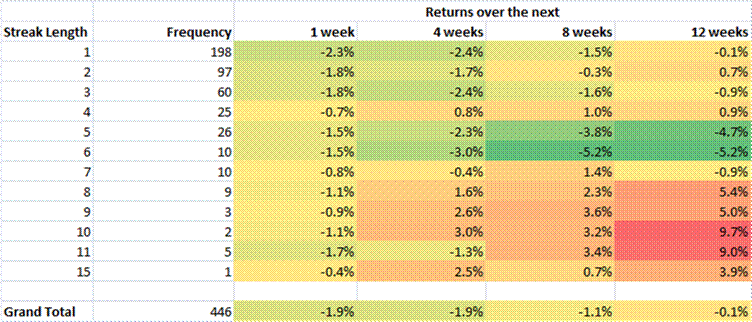Analyzing the Current NASDAQ Composite Streak Upwards
When I saw this piece from Barry, and this piece from Jason Goepfert on the eight-week Nasdaq streak, and read some of the questions, I said, “Hey, maybe I can help.”? After struggling with what defines a week (close of business for the week, Friday, or Thursday if the market was closed on Friday, or Monday in the second week of September 2001), I ran the numbers, and here is what I found:
Up Streaks

I used data from the Nasdaq Composite Index from inception in February 1971 through last Friday.? (Dividends not included in performance.)? Streaks longer than seven weeks are rare, but they tend to be associated with good performance in the next twelve weeks.? Again, the momentum effect is showing its face.? Interesting that intermediate length streaks of five and six weeks have done poorly over the next 12 weeks, whereas shorter streaks are just noise.? The frequency of streaks seems to follow an exponential decay pattern that is essentially coin-flip random, decaying at a rate of around 50%.
Down Streaks

Hey, if I have the data, shouldn’t I do the other side even if it is not immediately relevant?? The market was in a bull phase from 1971 until the present, so it doesn’t surprise me that after streaks downward that the market tends to rally, and after streaks upward the market meanders?? But long down streaks tend to bounce back hard (few observations, be careful), while the results after middling streaks are weak, and short downward streaks are stronger.? Again, there is exponential decay of streaks, near coin flip levels here as well.? Not surprising.
What does this tell about the current eight-week streak upwards?? With weak confidence it tells us that there is more room to move up.? Perhaps the Nasdaq Composite could be over 1900 by the end of July.? Given the lack of confidence in the rally, that is a genuine possibility.
Whether you run out and buy a bunch of QQQQs is your own business, but momentum tends to persist.? I don’t plan on buying the QQQQ.

